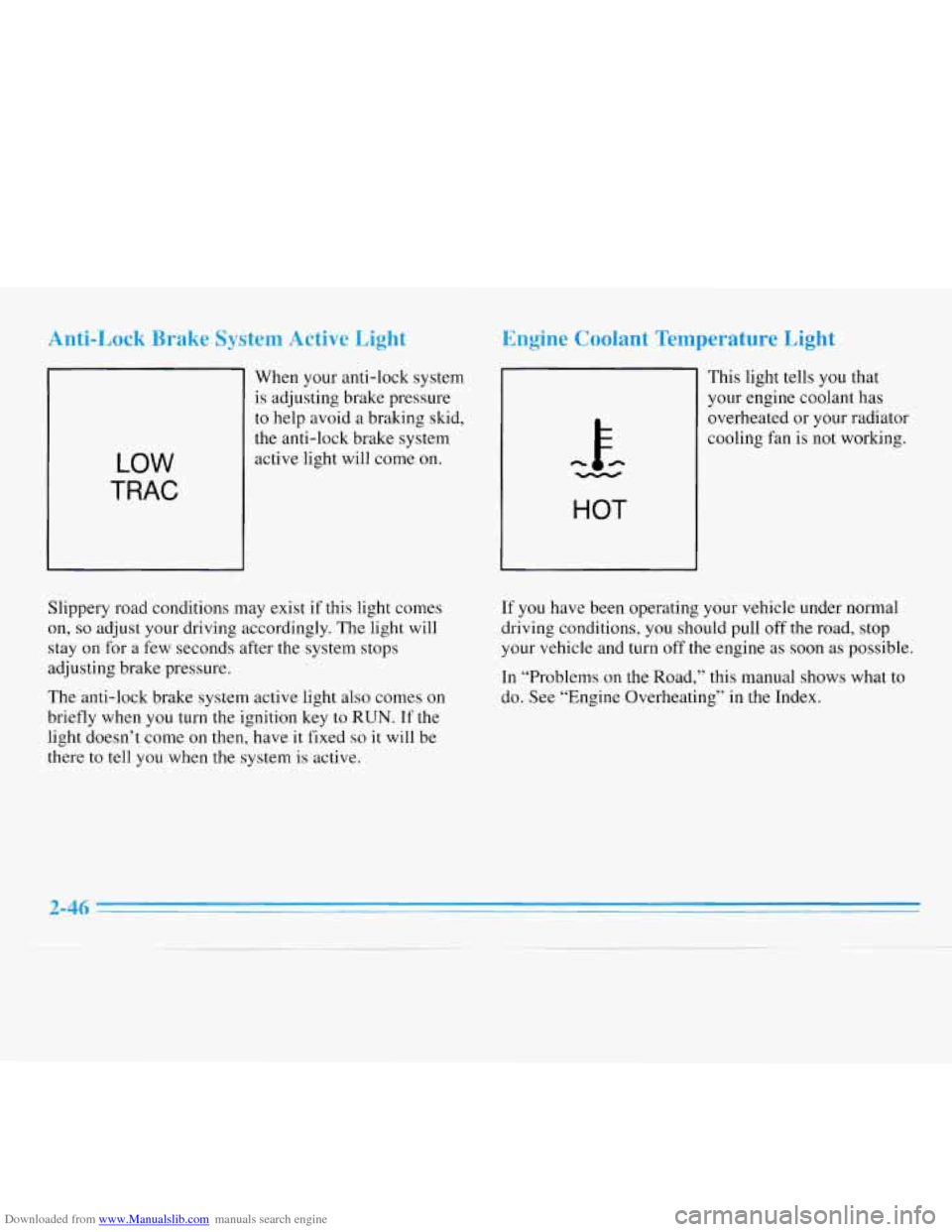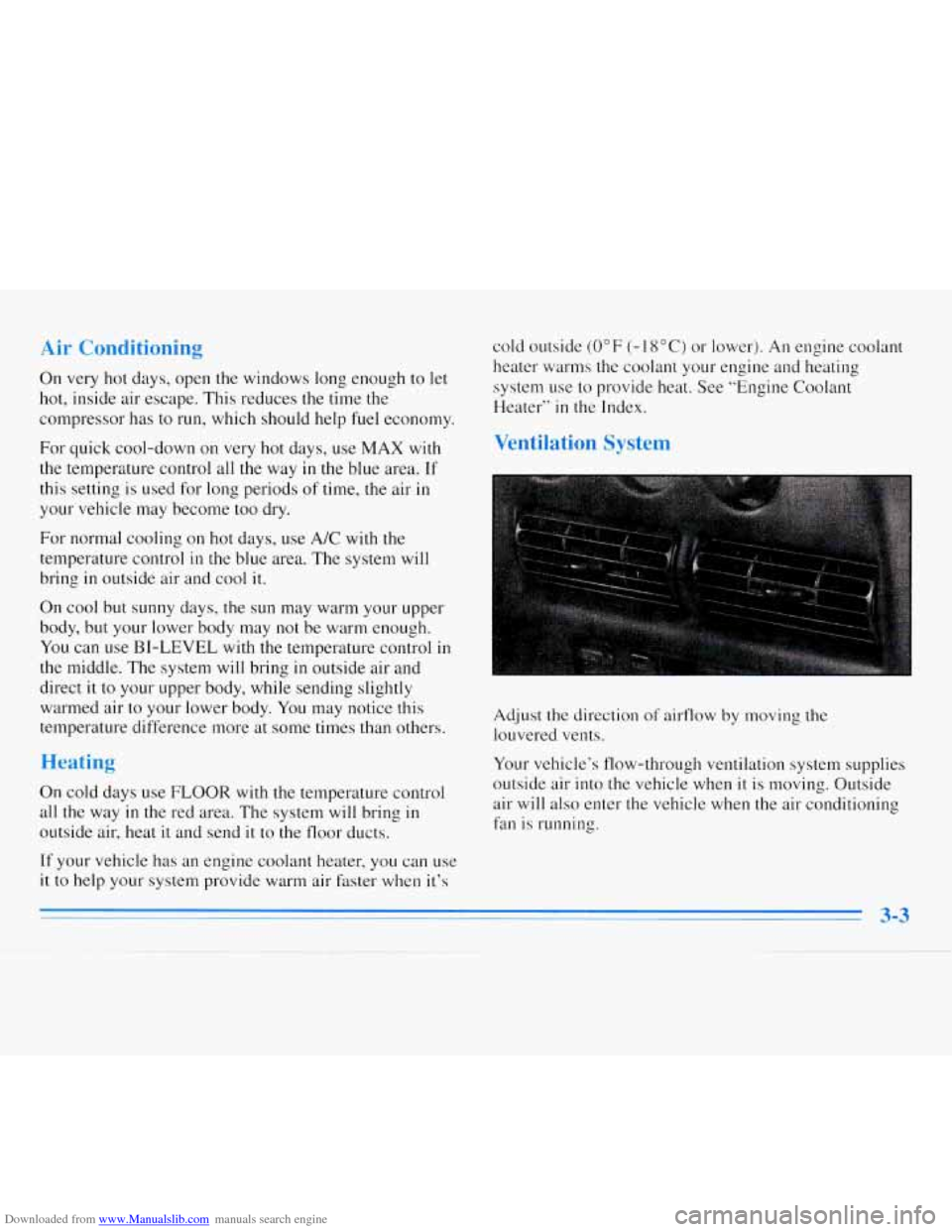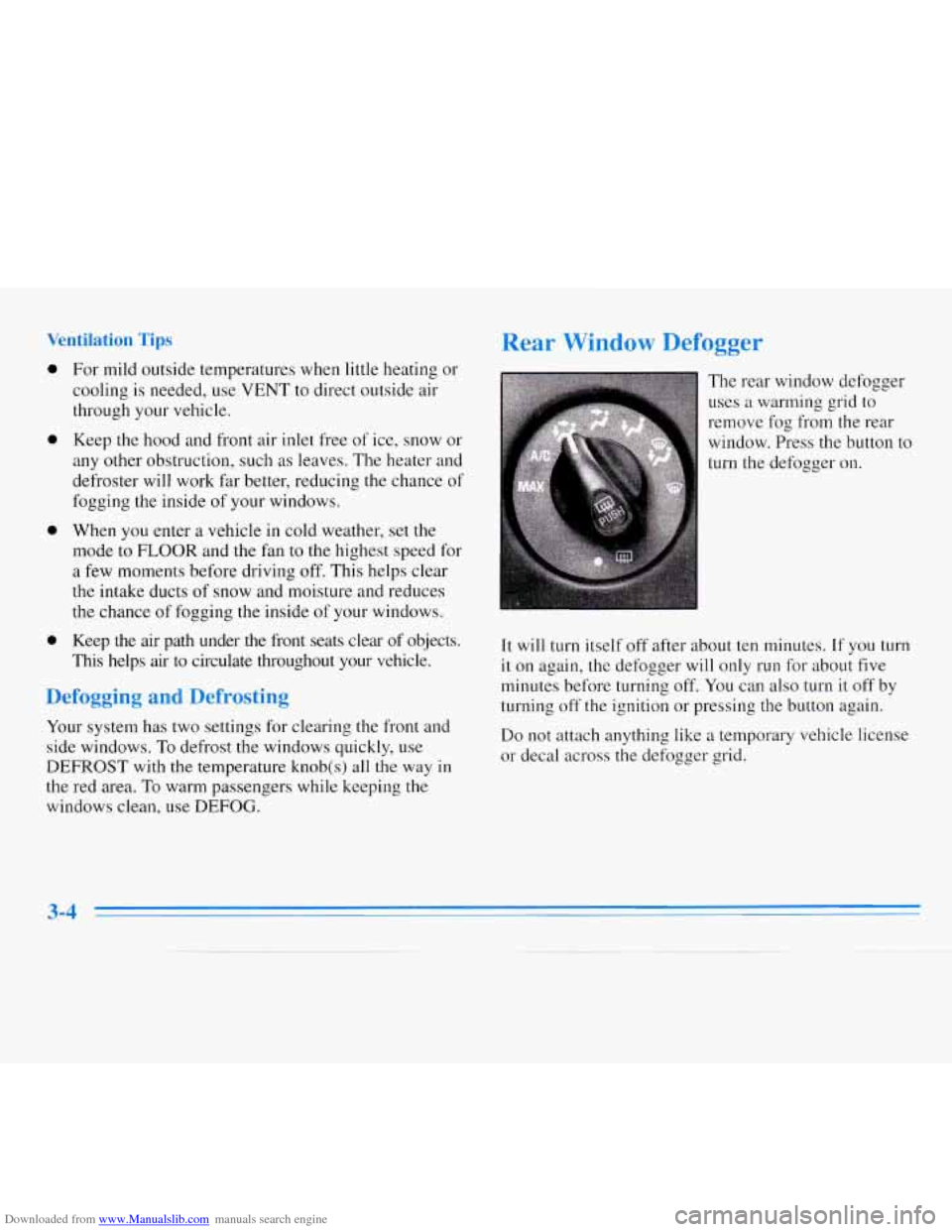Page 64 of 340
Downloaded from www.Manualslib.com manuals search engine Trunk Trunk Lock
It can be dangerous to drive with the trunk lid
open because carbon monoxide (CO) gas can
come into your vehicle. You can't see or smell
CO. It can cause unconsciousness and even death.
If you must drive with the trunk lid open or if
electrical wiring
or other cable connections must
pass through the seal between the body and the
trunk lid:
~ 0 Make sure all windows are shut.
0 Turn the fan on your heating or cooling
system to its highest speed with the setting
on VENT. That will force outside air into
your vehicle. See "Comfort Controls'' in
the Index.
instrument panel, open them all the way.
If you have air outlets on or under the
See "Engine Exhaust" in the Index.
To unlock the trunk from
the outside, insert the door
key and turn it.
You can also
use the Remote Lock
Control transmitter,
if your
vehicle has this option.
2-6
Page 104 of 340

Downloaded from www.Manualslib.com manuals search engine Anti-Lock Brake System Active Light
LOW
TRAC
When your anti-lock system
is adjusting brake pressure
to help avoid a braking skid,
the anti-lock brake system
active light will come on.
Engine Coolant Temperature Light
This light tells you that
your engine coolant has
overheated or your radiator
HOT
cooling fan is not working.
Slippery road conditions may exist if this light comes
on, so adjust your driving accordingly. The light will
stay on for a few seconds after the system stops
adjusting brake pressure.
The anti-lock brake system active light also comes on
briefly when you turn the ignition key to RUN. If the
light doesn’t come on then, have it fixed
so it will be
there
to tell you when the system is active. If
you have been operating your vehicle under normal
driving conditions,
you should pull off the road, stop
your vehicle and turn off the engine as soon
as possible.
In “Problems on the Road,” this manual shows what to
do. See “Engine Overheating”
in the Index.
Page 113 of 340
Downloaded from www.Manualslib.com manuals search engine 0 Section 3 Comfort Controls and Audio Systems
In this section you’ll find out how to operate the comfort
control and audio systems offered with your Chevrolet.
Be sure to read
about the particular systems supplied
with your vehicle.
Comfort Controls
Air Conditioning with Electronic Controls
With these systems, you can control the heating, cooling
and ventilation in your vehicle. The systems work best
if
you keep your windows closed while using them.
3-1
Page 115 of 340

Downloaded from www.Manualslib.com manuals search engine Air Conditioning
On very hot days, open the windows long enough to let
hot, inside air escape. This reduces
the time the
compressor has to
run, which should help fuel economy.
For quick cool-down on very hot days, use
MAX with
the temperature control all
the way in the blue area. If
this setting is used for long periods of time, the air in
your vehicle may become too dry.
For normal cooling on hot days, use A/C with
the
temperature control in the blue area. The system will
bring in outside air and cool
it.
On cool but sunny days, the sun may warm your upper
body, but your lower body may
not be warm enough.
You can use BI-LEVEL with the temperature control in
the middle. The system will bring in outside air and
direct
it to your upper body, while sending slightly
warmed air to your lower body.
You may notice this
temperature difference more at some times than others.
Heating
On cold days use FLOOR with the temperature control
all the way in the red area. The system will bring in
outside air, heat it and send it to the floor ducts. cold
outside
(0°F (-18°C) or lower). An engine coolant
heater warms the coolant your engine and heating
system use to provide heat. See “Engine Coolant
Heater”
in the Index.
Ventilation System
Adjust the direction of airflow by moving the
louvered vents.
Your vehicle’s flow-through ventilation system supplies
outside air into the vehicle when
it is moving. Outside
air
will also enter the vehicle when the air conditioning
fan is running.
If your vehicle has an engine coolant heater, you can use
it to help your system provide warm air faster when it’s
3-3
Page 116 of 340

Downloaded from www.Manualslib.com manuals search engine 0
0
0
0
ilation Ti-
For mild outside temperatures when little heating or
cooling is needed, use
VENT to direct outside air
through your vehicle.
Keep the hood and front air inlet free of ice, snow or
any other obstruction, such
as leaves. The heater and
defroster will work far better, reducing the chance of
fogging the inside of your windows.
When you enter
a vehicle in cold weather, set the
mode to FLOOR and the fan to the highest speed for
a few moments before driving off. This helps clear
the intake ducts of snow and moisture and reduces
the chance of fogging the inside
of your windows.
Keep the air path under the front seats clear of objects.
This helps
air to circulate throughout your vehicle.
Defogging and Defrosting
Your system has two settings for clearing the front and
side windows.
To defrost the windows quickly, use
DEFROST with
the temperature knob(s) all the way in
the red area. To warm passengers while keeping the
windows clean, use DEFOG.
Rear Window Defogger
The rear window defogger
uses a warming grid to
remove fog
from the rear
window. Press the button to
turn the defogger on.
I
It will turn itself off after about ten minutes. If you turn
it on again, the defogger will only run for about five
minutes before turning off. You can also turn
it off by
turning
off the ignition or pressing the button again.
Do not attach anything like a temporary vehicle license
or decal across the defogger grid.
3-4
Page 157 of 340
Downloaded from www.Manualslib.com manuals search engine Hill and Mountain Roads
Driving on steep hills or mountains is different from
driving in flat or rolling terrain.
If you drive regularly in steep country, or if you’re
planning
to visit there, here are some tips that can make
your trips safer and more enjoyable.
0
0
Keep your vehicle in good shape. Check all fluid
levels
and also the brakes, tires, cooling system
and transaxle. These parts can work hard on
mountain roads.
Know how to go down hills. The most important
thing to know
is this: let your engine do some of the
slowing down. Shift to
a lower gear when you go
down a steep or long hill.
If you don’t shift down, your brakes could get
so hot that they wouldn’t work well. You would
then have poor braking or even none going
down a hill. You could crash. Shift down to let
your engine assist your brakes on
a steep
downhill slope.
Page 170 of 340

Downloaded from www.Manualslib.com manuals search engine Parking on Hills
You really should not park your vehicle, with a trailer
attached, on a
hill. If something goes wrong, your rig
could start to move. People can be injured, and both
your vehicle and the trailer can be damaged.
But if you ever have to park your rig on a hill, here’s
how to do
it:
1.
2.
3.
4.
5.
Apply your regular brakes, but don’t shift into
PARK (P)
yet.
Have someone place chocks under the trailer wheels.
When the wheel chocks are in place, release the
regular brakes
until the chocks absorb the load.
Reapply the regular brakes.
Then apply your parking
brake, and then shift
to PARK (P).
Release the regular brakes.
When You Are Ready to Leave After
Parking
on a Hill
1. Apply your regular brakes and hold the pedal down
while
you:
Start your engine;
Shift into a gear; and
Release the parking brake.
2. Let up on the brake pedal.
3. Drive slowly until the trailer is clear of the chocks.
4. Stop and have someone pick up and store the chocks.
Maintenance When Trailer Towing
Your vehicle will need service more often when you’re
pulling
a trailer. See the Maintenance Schedule for more
on this. Things that are especially important
in trailer
operation are automatic transaxle fluid (don’t overfill),
engine oil, belts, cooling system and brake adjustment.
Each of these is covered
in this manual, and the Index
will help you find them quickly. If you’re trailering, it’s
a good idea to review these sections before you start
your trip.
Check periodically to
see that all hitch nuts and bolts
are tight.
Page 187 of 340
Downloaded from www.Manualslib.com manuals search engine If the coolant inside the coolant recovery tank is boiling,
don’t do anything else
until it cools down. A CAUTION:
Heater and radiator hoses, and other engine
parts, can be very hot. Don’t touch them.
If you
do, you can be burned.
Don’t run the engine if there is a leak.
If you run
the engine, it could lose all coolant. That could
cause an engine fire, and you could be burned.
Get any leak fixed before you drive the vehicle.
The coolant level should be at or above the COLD mark.
If it isn’t, you may have a leak in the radiator hoses,
heater hoses, radiator, water
pump or somewhere else in
the cooling system.
1 NOTICE:
Engine damage from running your engine
without coolant isn’t covered
by your warranty
If there seems to be no leak, with the engine on, check to
see
if the electric engine fans are running. If the engine
is overheating, both fans should be running.
If they
aren‘t, your vehicle needs service.